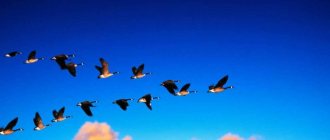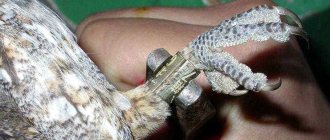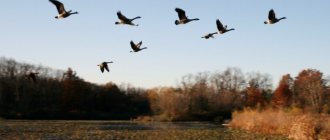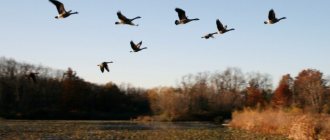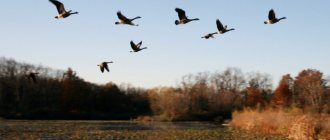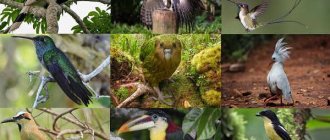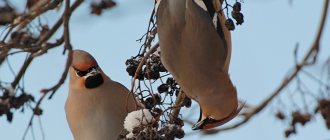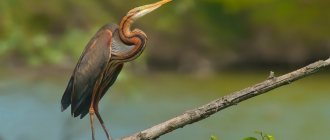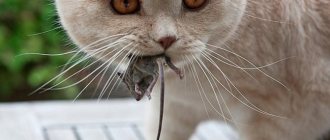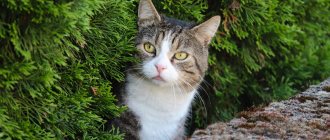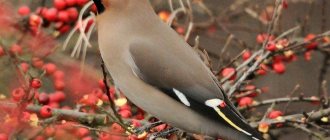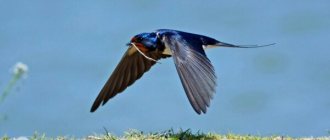Wonderful pictures with migratory and wintering birds. Which birds remain to spend the winter in their homeland, and which ones fly away?
Walking through a park or forest, we listen to birds singing and often simply don’t think about which bird trills so nicely. There are birds that live in our area all year round, but there are also those that fly to “warmer climes” in the fall.
Wild ducks in the sky
The fact is that in winter it is very difficult for birds to find food for themselves, because insects, berries and grains become scarce, and when snow falls, it is almost impossible to find them at all. And different species of birds solve this problem in different ways: migratory birds fly hundreds and even thousands of kilometers to warmer countries, while sedentary birds adapt to our harsh winters.
A tit in the snow, which apparently wants to eat some seeds
Settled, wintering birds: list, photos with names
To help the birds that remain over the winter find food, feeders are hung. And it is quite possible that they will be of interest to the following visitors:
- Sparrow . Noisy sparrows that fly in flocks may well become the first visitors to the feeder.
flock of sparrows
- Tit. Tits are in many ways not inferior to sparrows; they quickly rush to feed in feeders. But compared to sparrows, tits are endowed with a more gentle disposition. Interestingly, in the summer the tit eats almost as much food as it weighs. You can often see mixed flocks of both sparrows and tits at feeders.
Tit with a piece of bread
Sparrows and tit
- Gaichka . A close relative of the tit. However, the chickadee's breast is not yellow, but light brown. The chickadee also differs from other tits in that it makes a hollow in a tree to make a nest in it.
The chickadee is a special type of tit
- Crow. Ravens are often confused with rooks. It is known that in the western part of Russia crows are very rare. Therefore, if you live in the European part of Russia and see a black bird emitting a piercing croak, then most likely it is a rook.
Black Crow
- Pigeon. The distribution and lifestyle of pigeons was largely influenced by people who simply brought them with them to different parts of the Earth. Now pigeons are found on all continents except Antarctica. Pigeons easily exchange rocks, which are their natural habitat, for man-made structures.
The nodding gait of pigeons is due to the fact that this makes it easier for them to examine the object of interest to them.
- Woodpecker. In the warm season, woodpeckers feed mainly on insects, which they get from under the bark of trees, and in the cold winter, they can also feed on plant foods: seeds and nuts.
Woodpeckers love to eat seeds from pine and spruce cones.
- Magpie. The magpie is considered a bird of high intelligence; it is capable of expressing a lot of emotions, including sadness, and can recognize its reflection in the mirror. It is interesting that not only its fellow birds react to the alarming cry of a magpie, but also other birds, as well as wild animals, in particular bears and wolves.
Magpie - wintering bird
- Owl . Owls come in different varieties, large and small, and there are more than 200 species in total. These birds are endowed with acute vision and excellent hearing, which allows them to lead a nocturnal lifestyle. It is interesting that the tufts on the owl's head are not ears, the real ears of owls are hidden in the feathers, and one of them is directed upward, and the other downwards, in order to better hear what is happening above the head and on the ground.
Owl is a night bird
- Owl. This bird is also considered an owl and is a close relative of other owls.
Owl
- Tawny owl. A rare owl that lives mainly in mountainous areas in northern latitudes. The name of the bird, according to different versions, means “inedible” or “insatiable.”
Tawny Owl
- Jackdaw. Externally, jackdaws are similar to rooks and crows; moreover, there are mixed flocks in which all three species of birds can be seen. However, the jackdaw is smaller in size than the crow. And if you are lucky enough to observe a jackdaw up close, you can easily recognize it by the gray color of some of its feathers.
Jackdaws really like shiny objects
- Nuthatch. This little bird climbs tree trunks very deftly. In summer, nuthatches hide seeds and nuts in the bark, and in winter they feed on these supplies.
Nuthatch on a birch tree
- Crossbill. Like the nuthatch, this bird is excellent at climbing trees and can hang upside down on branches. Crossbill's favorite food is seeds from spruce and pine cones. This bird is remarkable in that it can hatch chicks even in winter, but only if there is enough food.
Crossbill on spruce branches
- Bullfinch. Only males have bright red plumage on the chest; females look much more modest. Bullfinches are more often seen in winter, because due to lack of food, they are drawn to people. In summer, bullfinches prefer wooded areas and behave inconspicuously, so they are not easy to see.
Pair of bullfinches
- Waxwing . A bird with beautiful plumage and a singing voice. In summer it feeds mainly on insects and likes to settle in coniferous forests. In winter, the waxwing moves to more southern regions of the country and is often found in cities. In the cold season, rowan and other fruits become the main food for birds.
Waxwing on a rowan branch in winter
- Jay. A large bird, which, however, can fly to feast on a feeder hung by people. In the summer it is rarely seen in the city, but closer to winter the bird begins to reach out to human habitation.
Jay in winter
- Kinglet. One of the smallest birds, the weight of an adult male is only 5-7 grams. Kinglets are relatives of sparrows.
Kinglet - forest dweller
- Pheasant . A large bird that is a favorite trophy for many hunters. Pheasants can fly, but most often move on foot.
Pheasant
- Hazel grouse . It is also an object of hunting, despite the fact that this bird is quite small. The weight of an adult hazel grouse rarely reaches 500 g. Interestingly, the largest population of these birds lives in Russia.
The hazel grouse is a bird that is related to the black grouse
- Black grouse. Another bird that is related to hunting. Black grouse are found at the edge of the forest and in the forest-steppe.
Grouse
- Sokol . It is considered one of the smartest birds on the planet and one of the best hunters. The falcon is capable of working in tandem with a person, but it is very difficult to tame it.
Falcon in flight
- Hawk . Like the falcon, it is a bird of prey. A hawk's vision is 8 times sharper than a human's. And rushing after prey, the hawk can reach speeds of up to 240 km/h.
Hawk
Resident birds
Zhelna (Dryocopus martius)
A representative of the woodpecker family called Zhelna lives settled on the territory of the Penza region. Birds migrate very rarely, exclusively between nesting periods. The body of the bird is slender, it is characterized by a long thin neck and a long tail. This woodpecker is distinguished by its large body size (up to 50 cm in length, wingspan about 80 cm, weight reaches 400 g), coal-black color and a bright scarlet cap on its head. You can meet it in old forests of various types, where there are tall trees suitable for knocking out hollows. They prefer to live alone, creating pairs during mating season. Their sonorous voice is clearly heard over long distances. The diet of the squirrel consists of insects.
Common nuthatch (Sitta europaea)
In the territory of deciduous and mixed forests, such an interesting species of birds as the common nuthatch, a bird of small size, but active and talkative, lives settledly. Occasionally it can be observed in parks and gardens in cities. Representatives of the species are up to 15 cm in length, have a wingspan of about 30 cm, and weigh about 25 g. The body is dense, with a large head on a short neck. The color of the top is made in bluish-gray tones, the belly is light, the sides are reddish, and a dark “mask” is visible on the eyes. The gray beak is well developed. The wings are short and dark. They are distinguished by the strength of their paws, which are grayish-brown in color, which help the bird to easily move through the trees in all directions. Vocalization of the nuthatch includes a wide variety of sounds: “tyu-tyu”, “ttsiiiiit”, “toooch”, “tteeg”, “tyu-tyuy”.
Common pika (Certhia familiaris)
Small funny pika birds also lead a sedentary lifestyle and are found in the Penza region. Observing them is not difficult, since these little ones do not pay attention to people and are not careful. They live mainly in forests. They have a curved long beak and a long tail. The plumage is motley-spotted above, with rufous below. The wings are brown above and white below. The feathers in the tail are very hard and are necessary for the pika to stay on the trees. Vocalization is represented by melodic whistling sounds, the song ends with a short syllable “blows”. A single call is high, sounds like a loud “tziiit”.
About other animals of our planet, look at the site: https://o-prirode.ru/
Migratory and nomadic birds: list, photos with names
- Rook. Rooks differ from crows in having a gray-yellow beak. In Kuban and Ukraine, you can see how in the fall rooks gather in huge flocks, so large that the sky seems black from the birds soaring in it - these are rooks that fly south. However, rooks are classified as migratory birds only conditionally, some of them remain to winter in central Russia, some winter in Ukraine, and only some birds fly to the warm shores of Turkey for the winter.
The sky in which rooks circle
- Rooks love to fly to freshly dug ground; sometimes they fly right behind a plowing tractor in order to have time to get as many worms and larvae as possible from the dug up ground.
Rook
- Nightingale. This inconspicuous bird with a singing voice loves warmth, and therefore flies south in the fall. And for wintering, our native nightingales chose hot Africa. These birds fly to the eastern part of the continent - Kenya and Ethiopia - for the winter. However, local residents cannot enjoy their singing, because nightingales sing only during the mating season, which takes place in their homeland.
Nightingale
- Martin. Swallows love rocky terrain; they often settle on the steep walls of quarries that people have dug. However, our winters are too harsh for swallows and therefore in the fall they fly to the southern part of Africa, far from us, or to Tropical Asia.
Swallow in flight
- Chizh . Like the rook, it is a migratory bird that arrives early and winters nearby: in the Caucasus, Kazakhstan and southern Europe. Externally, siskins are inconspicuous, their gray-green feathers are absolutely not noticeable against the background of the branches. The bird's temperament matches its appearance: quiet and meek.
Gray-green plumage of a siskin
- Goldfinch. In Europe it is a wintering bird, however, in Russia goldfinches can only be seen in summer. By winter, goldfinches gather in flocks and move to lands with a warmer climate. Goldfinches are close relatives of siskins.
The goldfinch is one of the most colorful birds
- Wagtail. A slender bird that runs quickly along the ground and shakes its tail with every step. Wagtails spend the winter in eastern Africa, southern Asia, and sometimes southern Europe.
Wagtail
- Quail. The only bird from the Galliformes order that is migratory. The weight of an adult quail is not so large and amounts to 80-150 g. In summer, quails can be found in fields sown with wheat and rye. Quails winter far beyond the borders of our homeland: in southern Africa and southern Asia, on the Hindustan Peninsula.
Quail in the grass
- Drozd . The song thrush, with its sweet trills, creates worthy competition for the nightingale. And his appearance, like that of the nightingale, is inconspicuous. In winter, blackbirds become Europeans: Italy, France and Spain are their second homeland.
song thrush
- Lark . Larks return from warm countries very early; sometimes already in March you can hear their sonorous song, which becomes a harbinger of spring warmth. And larks spend the winter in Southern Europe.
Lark in spring
- Seagull . With the onset of cold weather, seagulls living on the coasts of the northern seas migrate to the Black and Caspian Seas. But over the years, seagulls are increasingly drawn to people, and increasingly remain to spend the winter in cities.
Seagull on the warm coast
- Swift . Swifts winter in Africa, and fly to its equatorial part or even go to the southern part of the continent.
Swift
- Starling. Starlings really need birdhouses, since most often they breed their offspring in them. And our starlings go to Southern Europe and East Africa for the winter.
Starling
This bizarre black cloud is a flock of starlings returning home
- Chaffinch . Finches from the western part of the country winter mainly in Central Europe and the Mediterranean, and finches that live near the Urals in the summer go to winter in Southern Kazakhstan and the southern regions of Asia.
Chaffinch - a noisy inhabitant of the forest
- Heron . It is quite difficult to determine where herons spend the winter; some of them travel huge distances to South Africa, some winter in the Crimea or the Kuban, and in the Stavropol Territory, herons sometimes even remain for the winter.
Heron in a pond
- Crane . These birds are monogamous, and once having chosen a partner, they remain faithful to him throughout their lives. Cranes settle in swampy areas. And their wintering places are as diverse as those of herons: Southern Europe, Africa and even China - in all these parts of the world you can find cranes that have flown from Russia to spend the winter.
Cranes
- Stork . In Russia there are black and white storks. White storks build huge nests, up to one and a half meters wide, and make very long flights to the south. Sometimes they cross half the planet and reach South Africa, a country located in the very south of Africa.
Storks nest
- Swan . The swan is a bird that represents devotion and romance. Swans are waterfowl, so for wintering they choose places near water, often the Caspian or Mediterranean Sea.
Swan mother and her babies
- Duck . Wild ducks, as a rule, do not fly far in winter and remain in the vast expanses of post-Soviet states. It is noteworthy that their domestic relatives also begin to worry in the fall and sometimes try to fly away, sometimes they even fly over fences and fly short distances.
wild ducks
- Cuckoo . Cuckoos live in forests, forest-steppe, and steppe. The vast majority of cuckoos fly to tropical and South Africa for the winter; less commonly, cuckoos winter in South Asia: India and China.
Cuckoo
- Oriole . A small bird with a singing voice and bright plumage that flies to the tropics for the winter.
Oriole
- Robin . They wake up at dawn and are among the first to start the morning song. This little songbird used to be called a robin. Robins fly to Southern Europe, North Africa and the Middle East to spend the winter and are among the first to return home.
Robin
Predator birds
Buzzard (Buteo lagopus)
The feathered predator, the buzzard, has a body length of about 60 cm, and its weight reaches 1.5 kg. Externally, this bird is very similar to the common buzzard, but has several distinctive features. Namely: the belly of the buzzard is very light, almost white, and the plumage on the paws almost reaches the toes. The Rough-legged Rough-legged Bird is the most northern bird among its relatives, and lives in the open tundra and forest-tundra. As a migratory species for the winter, this predator goes to the south of the Eurasian continent. It is at wintering grounds that it is found in the Penza region. The diet of the buzzard consists of small mammals and birds. Vocalization, like the common buzzard, is represented by nasal drawn-out sounds “hieeee-hieeee”.
Meadow Harrier (Circus pygargus)
One of the harriers that nests in the Penza region is the meadow harrier. To live, this graceful, beautiful and dangerous feathered predator chooses open spaces near water bodies. The meadow harrier has long narrow wings and a long tail. In the air, it is easily recognized by its smooth, leisurely flight and wings elongated like the Roman numeral “V”, with two dark stripes below. Among its relatives, the meadow harrier is distinguished by the smallest size: up to 50 cm in length, wingspan about 1 m, weight approximately 300 g. The color of the upper body of the bird is ash-gray, the breast is lighter, red streaks are visible on the white belly and undertail. The wings and tail are dark and decorated with stripes. The meadow harrier hunts in open areas, catching prey both on the ground and in the air. Among the latter are rodents, small birds, and insects.
Short-eared owl (Asio flammeus)
The short-eared owl reaches 40 cm in length. This predator has a characteristic “owl-like” appearance. The top of the body is reddish in color, decorated with dark and light spots, the bottom is always lighter, against which dark brown spots are clearly visible. The head has short tufts of feathers, the so-called “ears.” Short-eared owls are very widespread in Eurasia and are not found only in countries with hot climates. They need moist lowlands for nesting. They can often be found near swamps. The thing is that short-eared owls make their nests right on the ground, in small holes that are lined with moss. The short-eared owl hunts small rodents, water birds, insects and fish.
What is the difference between migratory birds and wintering birds: presentation for preschoolers
Wintering and migratory birds: presentation for preschoolers
Slide 2
Slide 3: presentation of migratory birds Slide 4
Slide 5 Slide 6
Slide 7 Slide 8: presentation of wintering birds
Slide 9 Slide 10
Slide 11
Slide 12
Coloring site for children and adults:
The first bird in spring is considered to be the rook. There is a sign according to which the spring arrival of the rook means that the snow will melt in a month. He arrives in March.
The rook has arrived in the spring and is taking an important stroll...
Then, in the spring, everyone’s favorite starlings and larks come to us. These birds also arrive in March.
The starling and lark arrived in the spring
There is also a lapwing bird, which, depending on the region and its latitude, can arrive even in late February - early March.
Then in the spring wagtails, gulls, magpies, redstarts, thrushes, and cranes arrive.
Buntings arrive, ducks and geese occupy lakes and rivers, nightingales fill the forests.
Swallows, swifts, and of course cuckoos, etc. are returning.
We should not forget that nature influences the spring arrival of birds. Those birds that winter not so far away are the first to react to the arrival of early spring.
Everything in nature is reasonable! As soon as the ice on the rivers begins to melt, ducks and geese immediately arrive. Indeed, it would be stupid for them to arrive first, but the reservoir for them is still frozen and not ready.
In spring, ducks return to ponds
Heralds of spring, birds - signs
Birds have always been the heralds of spring. Among the people there are many signs and superstitions, holidays associated with the arrival of birds.
If you see a starling, it means spring is on the porch
The lark flies to the warmth
The goose calls to spring
Arrival of a swallow in the spring, to the imminent thunderstorms
The wagtail is small, and breaks the ice with its tail
Here they are - the first spring birds that fly to us, bringing us spring, warmth and joy on their wings.
We will be grateful to them for this.
Which of these birds, according to popular wisdom, builds its nest on the house where good people live?
Maybe a stork? :)
Nature is beautiful and all birds are good thanks to this site I learned the names of new birds
Here they are - the first spring birds that fly to us, Thanks for the information!?
Why do migratory birds fly to warmer regions where they spend the winter, and why do they come back?
Winter is a harsh test for birds. And only those who can get food for themselves in harsh conditions remain to spend the winter.
Bullfinch getting seeds
What could be the ways for birds to survive in the cold season?
- Some birds store food for the winter in the summer. They hide plant seeds, nuts, acorns, caterpillars and larvae in grass and cracks in tree bark. Such birds include the nuthatch.
- Some birds are not afraid of people and live near residential buildings. In winter, they find food in feeders and garbage heaps.
- Some birds are predators and feed on rodents. There are birds of prey that can feed on hares, hunt fish, small birds and bats.
Rowan saves many birds from hunger in winter.
If a bird can find food for itself in winter, it means it does not need to go on a tedious and difficult flight to warmer climes in the fall.
Bullfinches peck bread crumbs in a feeder
It would seem that everything is simple, and the only reason for the seasonal migration of birds is the lack of food. But in reality there are more questions here than answers. For example, imagine that a wild duck, which is a migratory bird, is provided with an artificially heated pond and a sufficient amount of food. Will she stay for the winter? Of course not. She will be called on a long journey by a strong feeling that is difficult to explain, called natural instinct.
Wild ducks in the sky
It turns out that birds fly to warmer regions, as if out of habit, because their ancestors did this for hundreds and thousands of years.
Chicks
Another question that requires an answer: why do birds return from warm countries every spring? Ornithological scientists have concluded that the beginning of the return flight is associated with the activation of sex hormones and the beginning of the breeding season. But why do birds fly thousands of kilometers and hatch their chicks exactly where they were born? Poets and romantic people say that birds, like people, are simply drawn to their homeland.
How do migratory birds know where to fly? A question to which to this day there is no clear answer. It has been experimentally proven that birds can navigate in completely unfamiliar terrain and in conditions of limited visibility, when neither the sun nor the stars are visible. They have an organ that allows them to navigate the Earth's magnetic field.
But the mystery remains how young individuals, who have never flown to warm regions before, find their own wintering place, and how do they know the route to fly? It turns out that in birds, at the genetic level, information about the point on the map where you need to fly is recorded and, moreover, a route to it is drawn.
Birds unerringly find their way to their wintering grounds
Description and features
Larks are small birds, ranging from 12 to 24 centimeters in length, weighing from 15 to 75 grams. The wings are wide, their span reaches 30-36 centimeters. The birds feel great in the sky: they demonstrate fast and well-controlled flight.
Like many land birds, most species of larks have a backward-facing finger that ends in a long claw. It is believed that this foot design provides stability when moving on the ground. These birds move on the ground very quickly.
The color of the plumage is not bright, but quite variegated. The main color scheme is gray-brown with light streaks. This outfit allows you to successfully camouflage yourself while moving along the ground. While in the nest, the bird completely merges with its surroundings.
Lesser Skylark
There are birds that have a color that is significantly different from the usual - these are black larks . This species is included in the genus of steppe larks. The color corresponds to the name: the bird is almost black. With a light border along the wings. This is reflected in the popular names: blackie, black starling, karaturgay (black lark, in Kazakh).
Birds molt once a year, after the end of the nesting period. The chicks molt completely in the fall after leaving the nest. They shed their brighter plumage and become indistinguishable from adult birds.
Crested lark
Adults feed mainly on seeds, while chicks are fed protein foods, that is, insects. Birds' beaks are slightly curved, well adapted for shelling seeds and digging in the ground to search for insects. There is no gender difference in size and proportions, and it is weakly expressed in color.
Which birds are the first and last to arrive in spring?
The rooks are the first to arrive in the spring . These birds return to their homeland in early spring, when the first thawed patches in the snow appear. With their strong beaks, rooks dig out larvae in such thawed areas, which form the basis of their diet.
The last to arrive are the birds, which feed on flying insects. These are swallows, swifts, and orioles. The diet of these birds consists of:
- Komarov
- Much
- Moshek
- Horseflies
- Zhukov
- Cicadas
- Butterflies
Since the emergence of a large number of adult flying insects from larvae requires warm weather and about two weeks of time, the birds that feed on them fly to their homeland after the mass appearance of these insects.
Geese are preparing to fly to warmer climes
first migratory when swallows arrive
Since childhood, we have been watching birds, without even thinking about which birds arrive with the first warmth. It is commonly believed that ducks are the harbingers of spring. But is it? We have put together a short article for you, which contains a calendar for the return of feathered comrades. You will learn when they arrive and what they do in their homeland, signs associated with them, and which winged creatures, on the contrary, fly away in the spring.
In what order do birds come home?
All migratory birds return to their homeland according to a certain calendar. Each family follows it from year to year, to the day, and strictly flies to the place where it began its journey for the winter.
Birds have a schedule for the sequence of arrivals, according to which you can find out which birds arrive first in the spring. Let's take a closer look.
Wagtails return home as soon as the snow begins to melt. In different areas this period begins from the end of February to March. Sometimes these birds can be seen swimming on drifting ice.
Second in line, but no less early, are the rooks. They arrive in their native places at about the same time as wagtails.
Other messengers of warmth
Next on the list are larks and starlings. With the arrival of the first ones, the air is filled with their sonorous singing. But the starlings quietly and silently begin to re-equip their nests.
It is interesting that the male starlings always arrive first, and only a week or two later the females.
Next comes a cute little bird - a finch. It is not difficult to recognize him: a blue head with a black forehead, red chest, throat and cheeks. It is often confused with the bullfinch, but the finch has a red back, yellow wings, and a green tail.
Right after the finch the thrush returns home. He evokes much admiration for his songs among those who love to walk in nature. Males begin to sing and build nests, attracting young females.
In mid-spring, redstarts return home. They are similar in size to sparrows, although their color is bluish.
Birds arriving in May
By the end of April, the forest full of foliage welcomes the nightingale into its arms. He delights those around him with his beautiful singing. Although the bird is completely inconspicuous from the outside, not distinguished by its special color, its songs cannot be confused with anything.
The very end of May is marked by the arrival of swallows. These are heat-loving creatures that arrive when the weather in nature is dry and hot. They like to set up their homes near people. Often nesting sites are balconies, rooftops and gorges above rivers. As a rule, swallows build a nest once and return to it every spring.
Signs about birds returning in spring
Since ancient times, there has been a sign: as soon as the birds return home, be sure to wait for warm days.
There are other signs that are passed down from generation to generation:
- if a bird builds a nest high in a tree, the summer will be cold;
- a large flock of migratory birds means a good, friendly spring;
- I saw feathered birds - wait for a change in the weather;
- rooks fly around their houses - expect trouble;
- the starling has arrived - spring has come;
- a swallow has built a nest near the house - to well-being and happiness in the family;
- if a swallow flies close to the ground, it means it will rain;
- The lark has returned quite early - spring and summer will be hot.
What do birds do when they fly to their native lands?
The birds that have returned to us after winter delight everyone with their loud singing. They are young, full of energy and strength, which is why they immediately begin arranging their homes. Thus, rooks first of all begin to actively restore their nests. Change downy bedding, rotted and broken branches, add new dry grass.
Basically, the males arrive first, regardless of the species. They are busy renovating the old house, and if there is no one left in the winter, they build a new one. By singing and screaming, they attract females, after which they lay eggs and begin to feed new young offspring.
Which bird flies away in the spring?
Yes, you were right, they are flying away. If you look at it precisely, the birds that come to us in the spring do not arrive, but fly past us. Depending on the region, birds are rising higher and higher to the north every week, into temperate latitudes. From this we can conclude that, for example, the nightingale, which migrates to North Africa in the fall, flies away from there in the spring to return to its native land.
Often by spring you can see bullfinches leaving their winter places. This is due to the fact that in the spring the breeding season begins, and they have to look for new nesting sites.
If you liked the article, share it with your friends on social networks, comment and like.
ptitsadoma.ru
What flock of migratory birds promises snow?
geese has flown south , you should expect the first snow to fall. This sign may not coincide with real weather phenomena. So in the north of Russia, geese fly to warmer climes in mid-September, and snow can fall much earlier. Let's say the first snow in Norilsk this year fell on August 25th. In the south, geese fly to warmer climes at the end of October, and sometimes even at the beginning of November. The first snow in these areas may occur around this time. But it all depends on the weather conditions in autumn. Indian summer here can last throughout October.
VIDEO: Geese gather in flocks to fly south
Nutrition
The basis of the diet for larks is insects and grains. Food is obtained by pecking insects and grains from the ground or from plants, from their own height. Various beetles are used. In addition to Coleoptera, larks do not disdain Orthoptera or wingless ones.
That is, everyone who can be caught up with, with whom their beak and muscular stomach can handle. Since food is obtained only on foot, the lark gets grains that have already fallen or are low-growing. Unfortunately, these small songbirds are food themselves.
Not just for predators. In the south of France, Italy, and Cyprus, delicious dishes are traditionally prepared from them. They are stewed, fried, and used as a filling in meat pies. Dishes made from the tongues of larks are considered an exquisite treat worthy of royalty. This is the fate of not only larks, but many migratory birds.
Which bird from the order Galliformes is migratory?
A migratory bird from the order Galliformes is the quail . The quail's habitat extends beyond Russia in the west and south. In the east, these birds live up to the western coast of Lake Baikal. They are widespread in Europe, Western Asia and Africa.
Quail habitat
For the winter they fly south. And they winter in Hindustan, Northern Africa and South-West Asia.
Lark - a harbinger of spring
The lark is one of the most famous singing representatives of birds. He delights five continents with spring trills. A space object is named in his honor: the asteroid Alauda (translated from Latin: lark).
Common lark
What do birds do when they fly to their native lands?
The birds that have returned to us after winter delight everyone with their loud singing. They are young, full of energy and strength, which is why they immediately begin arranging their homes. Thus, rooks first of all begin to actively restore their nests. Change downy bedding, rotted and broken branches, add new dry grass.
Basically, the males arrive first, regardless of the species. They are busy renovating the old house, and if there is no one left in the winter, they build a new one. By singing and screaming, they attract females, after which they lay eggs and begin to feed new young offspring.
Birds arriving in May
By the end of April, the forest full of foliage welcomes the nightingale into its arms. He delights those around him with his beautiful singing. Although the bird is completely inconspicuous from the outside, not distinguished by its special color, its songs cannot be confused with anything.
The very end of May is marked by the arrival of swallows. These are heat-loving creatures that arrive when the weather in nature is dry and hot. They like to set up their homes near people. Often nesting sites are balconies, rooftops and gorges above rivers. As a rule, swallows build a nest once and return to it every spring.
